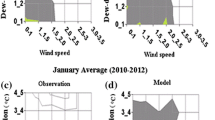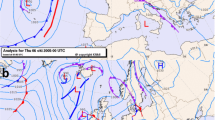Abstract
We present a study of a persistent case of fog and use the observations to evaluate the UK Met Office ensemble model. The fog appeared to form initially in association with small patches of low-level stratus and spread rapidly across southern England during 11 December 2012, persisting for 24 h. The low visibility and occurrence of fog associated with the event was poorly forecast. Observations show that the surprisingly rapid spreading of the layer was due to a circulation at the fog edge, whereby cold cloudy air subsided into and mixed with warmer adjacent clear air. The resulting air was saturated, and hence the fog layer grew rapidly outwards from its edge. Measurements of fog-droplet deposition made overnight show that an average of 12 g m\(^{-2}\) h\(^{-1}\) was deposited but that the liquid water content remained almost constant, indicating that further liquid was condensing at a similar rate to the deposition, most likely due to the slow cooling. The circulation at the fog edge was also present during its dissipation, by which time the fog top had lowered by 150 m. During this period the continuing circulation at the fog edge, and increasing wind shear at fog top, acted to dissipate the fog by creating mixing with, by then, the drier adjacent and overlying air. Comparisons with a new, high resolution Met Office ensemble model show that this type of case remains challenging to simulate. Most ensemble members successfully simulated the formation and persistence of low stratus cloud in the region, but produced too much cloud initially overnight, which created a warm bias. During the daytime, ensemble predictions that had produced fog lifted it into low stratus, whilst in reality the fog remained present all day. Various aspects of the model performance are discussed further.















Similar content being viewed by others
References
Bowler NE, Arribas A, Mylne KR, Robertson KB, Beare SE (2008) The MOGREPS short-range ensemble prediction system. Q J R Meteorol Soc 134:703–722
Brown AR, Beare RJ, Edwards JM, Lock AP, Keogh SJ, Milton SF, Walters DN (2008) Upgrades to the boundary-layer scheme in the Met Office Numerical Weather Prediction Model. Boundary-Layer Meteorol 128:117–132
Choularton TW, Fullarton G, Latham J, Mill CS, Smith MH, Stromberg IM (1981) A field study of radiation fog in Meppen, West Germany. Q J R Meteorol Soc 107:381–394
Clark PA, Harcourt SA, Macpherson B, Mathison CT, Cusack S, Naylor M (2008) Prediction of visibility and aerosol within the operational Met Office Unified Model. Part 1: model formulation and variational assimilation. Q J R Meteorol Soc 134:1801–1816
Duynkerke PG (1991) Radiation fog: a comparison of model simulation with detailed observations. Mon Weather Rev 119:324–341
Duynkerke PG (1999) Turbulence radiation and fog in Dutch stable boundary layers. Boundary-Layer Meteorol 90:447–477
Fuzzi S, Facchini MC, Orsi G, Lind A, Wobrock W, Kessel M, Maser R, Jaeschke W, Enderle KH, Arends BG, Berner A, Solly I, Kruisz C, Reischl G, Pahl S, Kaminski V, Winkler P, Ogren JA, Noone KJ, Hallberg A, Fierlinger-Oberlinninger H, Puxbaum H, Marzorati A, Hansson HC, Wiedensohler A, Svenningsson IB, Martinsson BG, Schell D, Georgii HW (1992) The Po Valley Fog Experiment 1989. An overview. Tellus 44B:448–468
Grachev AA, Fairall CW, Persson POG, Andreas EL, Guest, PS (2005) Stable boundary-layer scaling regimes: the Sheba data. Boundary-Layer Meteorol 116:201–235
Guedalia D, Bergot T (1994) Numerical forecasting of radiation fog. Part II: a comparison of model simulation with several observed fog events. Mon Weather Rev 122:1231–1246
Gultepe I, Tardif R, Michaelides SC, Cermak J, Bott A, Bendix J, Muller M.D., Pagowski M, Hansen B, Ellrod G, Jacobs W, Toth G, Cober SG (2007) Fog research: A review of past achievements and future perspectives. Pure Appl Geophys 164:1121–1159
Horlacher V, Osborne S, Price JD (2012) Comparison of two closely located meteorological measurement sites and consequences for their areal representativity. Boundary-Layer Meteorol 142:469–493
Lenschow DH, Mann J, Kristensen L (1994) How long is long enough when measuring fluxes and other turbulent statistics? J Atmos Sci 11:661–673
Meyer MB, Lala GG, Jiusto JE (1986) FOG-82—a cooperative field study of radiation fog. Bull Am Meteorol Soc 65:825–832
Price JD (2002) A semi-emperical parametrization for total in situ specific humidity standard deviation derived from tethered balloon observations. Q J R Meteorol Soc 128:733–739
Price JD (2011) Radiation fog Part I: observations of stability and drop size distributions. Boundary-Layer Meteorol 139:167–191
Price JD, Clark R (2014) On the measurement of dewfall and fog droplet deposition. Boundary-Layer Meteorol 152:367–393. doi:10.1007/s10546-014-9930-6
Roach WT, Brown R, Caughey SJ, Garland JA, Readings CJ (1976) The physics of radiation fog: I—a field study. Q J R Meteorol Soc 102:313–333
Rodhe B (1962) The effect of turbulence on fog formation. Tellus 14:49–86
Schotanus P, Nieuwstadt FTM, De Bruin HAR (1983) Temperature measurement with a sonic anemometer and its application to heat and moisture fluxes. Boundary-Layer Meteorol 26:81–93
Smith RNB (1990) A scheme for predicting layer clouds and their water content in a general circulation model. Q J R Meteorol Soc 116:435–460
Taylor GI (1917) The formation of mist and fog. Q J R Meteorol Soc 43:241–268
Vautard R, Yiou P, van Oldenborgh GJ (2009) Decline of fog mist and haze in Europe over the past 30 years. Nat Geosci 2:115–119
Acknowledgments
Staff at the UK Met Office Research Unit, Cardington are acknowledged for their significant help to collect the data used in this study. Nigel Roberts and Dan Harris are acknowledged for their comments and help and many thanks to Volker Horlacher for providing data on the error metrics for the sonic anemometer observations. The comments of the reviewers are also appreciated.
Author information
Authors and Affiliations
Corresponding author
Appendix
Appendix
In this section details of instrumentation and their characteristics are presented.
1.1 Wind and Turbulence
Gill HS50 and HS100 sonic anemometers are used for wind and turbulence measurement. These sample at 50 and 100 Hz respectively, but are averaged to 10 Hz for the analysis presented here. The native temperature measurement from a sonic anemometer is virtual temperature, and therefore the derived heat fluxes are likewise, following (Schotanus et al. 1983),
where \(T_\mathrm{v}\) is the virtual temperature, \(w\) is vertical velocity, \(T\) is sensible temperature, \(q\) is specific humidity, \(u\) is horizontal velocity and \(c\) is the speed of sound. Primes indicate deviations from the average. In practice the second and third terms on the right-hand side are small and are often ignored (e.g. Grachev et al. 2005). In this study it is estimated that ignoring these terms introduces an error of approximately 5 % into the sensible heat fluxes, which is considered negligible and the terms have been ignored. The instruments themselves have inherently good reproducibility: a recent intercomparison over two weeks between seven sonic anemometers at Cardington, placed in a line with 15-m separation, produced turbulence statistics that agreed to within 4 % (standard deviation). Errors in the vertical velocity variance and heat fluxes have been estimated using the methodology of Lenschow et al. (1994), which provides percentage errors. The values were averaged over daytime (0630–1830 UTC) and nighttime (1830–0630 UTC) periods separately to ensure confidence in values calculated during the light wind night time periods. Sonic measured temperatures are only used in the calculation of fluxes, and not for any temperature analysis, since they are less accurate than other measurements.
Turbulence measurements presented are therefore calculated by the eddy-covariance technique, calculated over 10-min periods (other averaging periods of 5 and 30 min were found to produce similar results, though with higher variance). Before calculations are made, a tilt correction is applied (if the sonic is not level), the data are rotated into the mean wind direction (simple Cartesian method), a cross-wind correction is applied to the temperature, and a linear detrend to remove large-scale effects from the data is applied. All data were examined visually for spikes and other anomalies (these were rare) which were removed from the analysis when present.
1.2 Temperature Measurements
A reference temperature measurement is taken at heights of 1.2, 10, 25 and 50 m. These are made using Vector Instruments platinum resistance thermometers with a calibration uncertainty of 0.1 \(^{\circ }\)C, and a response rate of approximately 30 s. These are the default measurements for temperature analysis presented herein. A Heitronics infrared thermometer was used to measure surface temperature. Due to uncertainties in the emissivity of different surfaces and their wetness, the uncertainty of the measurement is taken to be \(\pm \)1 \(^{\circ }\)C, in line with the manufacturer’s recommendations.
1.3 Radiation
Radiative fluxes are measured with Kipp and Zonen instruments. Upwelling and downwelling shortwave fluxes are measured with CM21 and CM22 pyranometers respectively. These usually agree to within 2 W m\(^{-2}\) with a standard reference instrument. Longwave fluxes are measured with CG4 pyrgeometers, which usually show agreement to about 3 W m\(^{-2}\) with a reference.
1.4 Visibility
Visibility is measured at Cardington with a Belfort 6230A visiometer, with a manufacturer’s quoted uncertainty of 10 %. A recent intercomparison with two HSS devices showed agreement to about 7–8 % averaged for all visibilities ranging from 100 m-40 km.
1.5 Cloud-Base Measurement
Cloud base was determined using a Vaisala LD40 ceilometer.
1.6 Liquid Deposition
This was measured using a custom built micro-lysimeter on which different canopy types can be used. Details are given in Price and Clark (2014).
1.7 Cloud-Droplet Spectra
These were measured with a Droplet Measurement Technologies cloud-droplet probe (CDP). The device has been adapted by DMT for low airspeed use. Spectra were measured at 2 m or on a tethered balloon system. The device was run naturally aspirated on a wind vane for some measurements, and with an aspirator for others. Comparison showed that apart from the number of counts registered, spectra were similar for both techniques. On the tethered balloon system winds are measured with Gill anemometers separated by 2 m vertically from the CDP and were used to calculate liquid water content and number density in conjunction with the CDP that was naturally aspirated. When operated aspirated at 2-m height, wind speed was measured with a venturi at the beginning and end of the measurement period, and an average value used. Because of the lower flow rates during this experiment the integration period was set at 5 or 10 s for an individual spectra. Overall results were not sensitive to this figure, but no additional statistically valid information was collected with a shorter sampling period. Spectra presented for longer periods are a simple sum of the 10-s integrations. The CDP is tested for its accuracy to size particles by using standard glass bead tests. No independent measurements were available for liquid water and number density, but it is estimated uncertainty could be as large as a factor of two for each, which is similar to results from other probes of the same nature (Phil Brown, UK Met Office, personal communication, 2010).
Rights and permissions
About this article
Cite this article
Price, J., Porson, A. & Lock, A. An Observational Case Study of Persistent Fog and Comparison with an Ensemble Forecast Model. Boundary-Layer Meteorol 155, 301–327 (2015). https://doi.org/10.1007/s10546-014-9995-2
Received:
Accepted:
Published:
Issue Date:
DOI: https://doi.org/10.1007/s10546-014-9995-2




